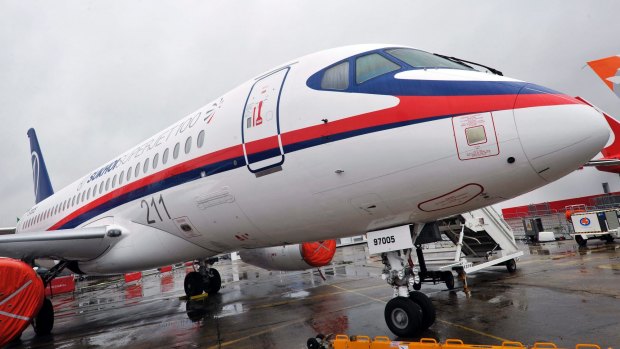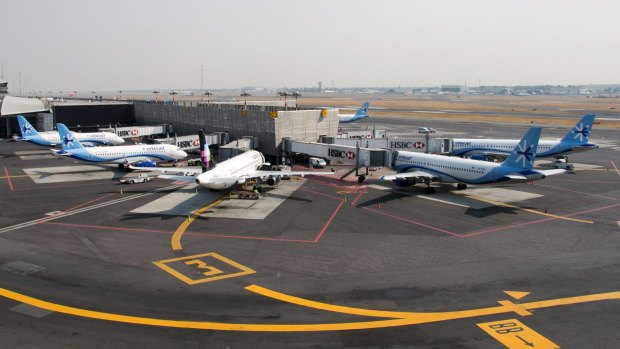This was published 6 years ago
Interjet's grounded Sukoi Superjets in Mexico being used for spare parts
By Andrea Navarro

Interjet's fleet of Sukhoi Superjet 100s is being kept in the air using parts from four of its grounded planes.Credit: AP
In cavernous jet hangars in and around Mexico City, Interjet has a secret.
Four of the Mexican airline's Sukhoi Superjet 100s - out of a fleet of 22 - have been grounded for at least five months because of engine maintenance delays. The Russian-made aircraft, which average just four years old, are now being cannibalised, an industry term for when a plane is slowly scrapped for parts to keep other jets running.
A grounded plane is a wasted plane, and Interjet's offline aircraft are symbolic of an airline that's veered off course. Once one of Mexico's hopefuls to bring a new era of competition to the industry, Interjet has muddled along with a questionable strategy while more nimble rivals have appeared on the scene. Now, the stranded Sukhoi Superjets are adding to concerns about whether ABC Aerolineas, the company's formal name, will ever thrive.

Interjet planes sit on the tarmac at Benito Juarez International Airport in Mexico City.Credit: Bloomberg
"There are doubts about the viability of the business," says Carlos Ozores, an air-transport specialist at ICF, a consulting and technology services company based in Virginia. "The only way for an airline to make money is to keep flying."
Interjet confirmed the grounded aircraft but said it's in good financial shape. The parked-plane situation can be traced back to a decision Chief Executive Officer Jose Luis Garza made half a decade ago when he agreed to buy the little-known and largely untested Sukhoi Superjets, which are backed by Italy's Leonardo and Russia's Sukhoi. The engines are made by France's Safran and a Russian partner.
JSC Sukhoi doesn't have a single maintenance facility in the Americas. Airbus, which services the rest of Interjet's fleet, operates three. That's important because planes need regular and meticulous upkeep. It's like driving a Hummer in a land of Volkswagens. For a time you'll be fine, but once the vehicle requires so much as a tune-up, finding the parts and the labor to fix it will be both tricky and costly.
"The supply chain with this aircraft has been a process," Garza says from his office overlooking the Mexico City airport. "But we're getting to where we want to be with them." To ease maintenance problems, a $US7 million ($A8.8 million) consignment stock is being set up this year with Sukhoi parts, he said.
"The decision to buy them was a technical and economical one," he says, calling the deal an "extraordinary acquisition agreement" the company wouldn't have gotten from Brazilian maker Embraer.
Interjet made a splash as Mexico's first airline for the budget-conscious flyer when it was founded in 2005 by the Aleman family, the son and grandson of a former president. The company's regional focus and deeply discounted ticket prices quickly turned it into the No. 2 airline by passengers as of 2011. But in the years that followed, the carrier hit turbulent skies, causing the company's overall market share to stagnate while ultra-low-cost rival Controladora Vuela Compania de Aviacion, known as Volaris, has seen its stake soar.
"It'll be hard for it to survive without a change of strategy," Ozores says. "It's hard operating in the middle."
The middle that Ozores is referring to is the point between low-cost carrier and a full-service one. Interjet's original economic model has slowly morphed into a sort of hybrid, so that these days, the carrier is trying to compete on price and service -- and falling short on both fronts.
Garza says Interjet has focused its growth strategy on international routes since 2014, almost doubling its share of foreign flights to and from Mexico to about 21 percent as of November from 11 percent in 2014.
While that's helped boost the company's dollar income -- a boon for companies battered by a local currency that's lost a third of its value in five years -- Interjet has paid a heavy price to compete with its bigger rivals.
Interjet freebies likes snacks and checked luggage put its costs on par with full-service rivals like Grupo Aeromexico. It also boasts of comfy leg room, adapting the seating configuration on its Airbus aircraft so that its planes fly an average 13 percent below capacity. Despite those perks, Interjet's image is still solidly stuck in the domain of budget carriers. But its prices are sometimes more than double those of Volaris, which started operations in 2006.
"We're told we're leaving money on the table," Garza says. "Does that mean we should overbook flights and start charging for everything? We don't think so."
Meanwhile, Interjet's leverage -- Bloomberg estimates net debt is 7.1 times earnings before interest, taxes, depreciation, amotization and rent -- tops Aeromexico's ratio of 5.1 or Volaris's 5.2 times. Says Michael Duff, director at data researcher The Airline Analyst: "A relatively high financial risk is how I'd categorize them."
It's for that reason that keeping a constant eye on costs is so crucial. For low-cost carriers, that usually means limiting fleets to a single aircraft to save on maintenance-training costs. But Interjet's 22 Superjet 100 planes coexist with its 50 Airbus A320 jetliners as well as six Airbus A321 aircraft.
"The most important defining characteristic of a low-cost carrier is an airline that's able to keep costs low, whatever way they manage to do it," says Triant Flouris, an International Air Transport Association flight instructor and academic at the Hellenic American University in Greece.
It was about a year ago that CEO Garza's decision to bet on the Sukhoi Superjet first came back to haunt him in a big way. In December 2016 -- peak travel season for holiday flyers -- the Russian aviation authority warned of a defect in a part that helps the aircraft fly straight in the air. After Interjet inspected its own planes, it grounded half its Sukhoi Superjet fleet and was forced to cancel 25 flights, Garza said at the time.
Although the planes were back in service by the following month, the damage was done. Some consumers began a social media campaign to pressure Mexico's consumer watchdog to ban Interjet from flying the planes ever again, although nothing came of the requests.
"The Superjet hasn't become very popular outside of Russia," Flouris says. "Most of the airlines that I've seen flying this jet are closer to Russia."
The 2012 Sukhoi Superjet purchase was the best choice for Interjet given Mexico City's temperatures, altitudes and the routes they were intended to cover, CEO Garza says. It was a bold bet on Russia's first major passenger aircraft since the collapse of the Soviet Union.
The single-aisle aircraft sold for about a half of the price of comparable jets from Brazil's Embraer or Canada's Bombardier Inc. During a promotional flight in May 2012 -- just three months before Interjet exercised an option to buy more planes -- one of the first Sukhoi Superjets ever produced crashed into a mountain in Indonesia, killing all 45 aboard. Indonesian investigators said human error was the most likely cause.
Sukhoi did not respond to requests for comment.
Today, Interjet is Sukhoi's second-biggest customer -- behind only Aeroflot. Interjet board Chairman Miguel Aleman Velasco said at an October event that the company is even considering adding to its Russian-made fleet with the purchase of Sukhoi's twin-engine MS-21s when they roll out in 2019.
Interjet has some financial challenges to overcome in the meantime. Financial reports show maintenance costs are rising faster than other expenses, and they now top what Aeromexico pays to keep its planes running, Duff says. Aircraft-leasing firms have boosted deposit requirements for the airline, Bloomberg Intelligence analyst George Ferguson says, adding that "lessors are probably paying close attention to their operations." Out of its 78-aircraft fleet, the company owns 30 and leases the rest.
A 3.2 billion-peso cash injection put forth by the Aleman family last year helped the company pay down most of its short-term liabilities. The company's financial debt of about 12.4 billion pesos is made up of 800 million pesos in Cebures -- a type of domestic bond -- and bank loans in dollars with an average maturity of four years, Chief Financial Officer Raul Lopez says.
"We paid down short-term debt because that's what had analysts worried," Garza says.
Mexico's government has reason to be worried, too. The nation took a major blow when Mexicana de Aviacion filed for bankruptcy and ceased operations in 2010. Mexicana's chairman was charged with alleged embezzlement (the charges were later dropped), and hundreds of pilots and flight attendants saw large chunks of their pension funds shrink. Mexico's aviation market, meanwhile, lost one of its biggest players, opening the void that Interjet, Volaris and Aeromexico would ultimately fill.
The Aleman family has flirted with the idea of taking the company public for several years. In 2011, an IPO was scrapped at the last minute after a slumping Mexican market and higher fuel costs weakened investor demand. In 2013, Chairman Aleman Velasco said the company, which holds valuable takeoff and landing rights at Mexico City's crowded airport, planned to raise as much as $US1 billion with a stake sale of up to 25 per cent.
The carrier last year sought to sell an equity stake to a foreign airline such as American Airlines Group Inc. or United Continental Holdings Inc., Aleman Velasco told Bloomberg in an interview in late 2016. No announcement was ever made.
Both options -- an equity stake first, then an IPO -- are still on the table and expected by the end of this year or next, Garza says.
"The family is going to put as much money into it as they need to keep the lessors financing it," Ferguson says. "At the end of the day, family money is patient."
The Washington Post
See also: First A380 retired, parked in mountains awaiting sale or scrap
See also: Into the boneyard: Where the old 747 jumbo jets go to die
Sign up for the Traveller Deals newsletter
Get exclusive travel deals delivered straight to your inbox. Sign up now.